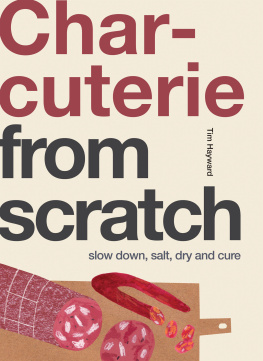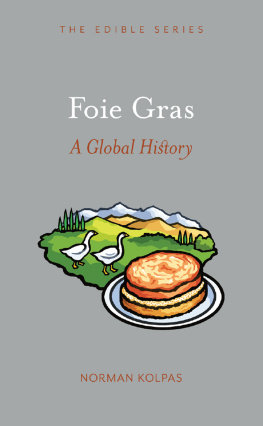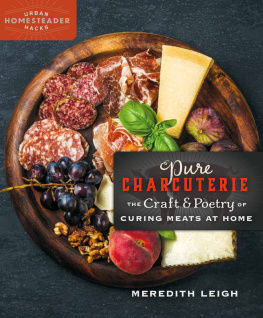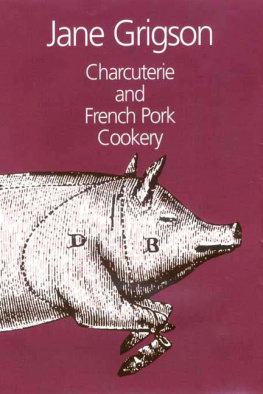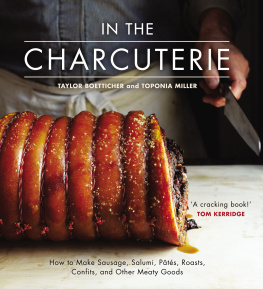Contents
Guide
Page List
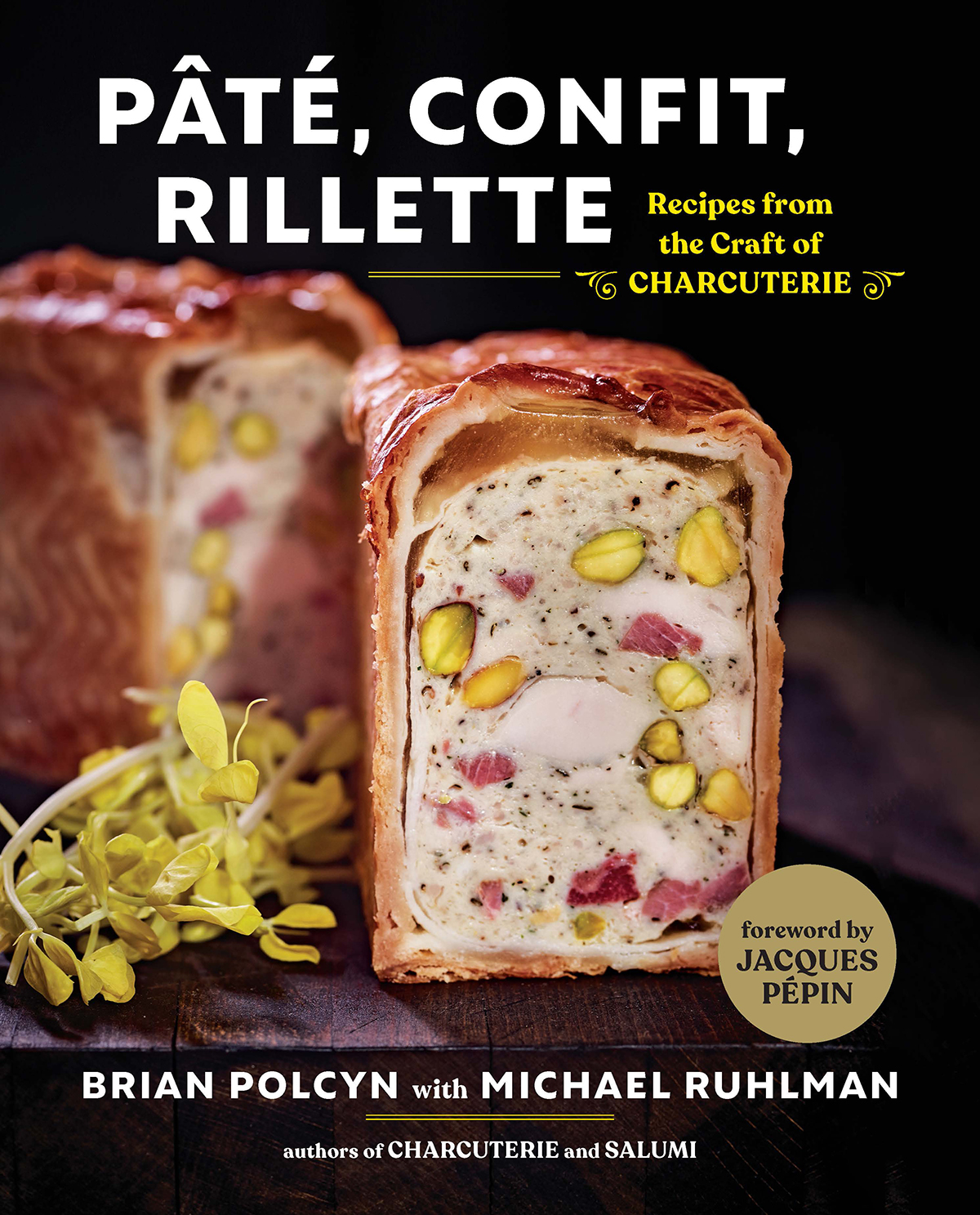
ADDITIONAL PRAISE FOR PT, CONFIT, RILLETTE
A hymn to extreme scrumptiousness. A how-to for making
some of the greatest, trickiest foods you will ever have the privilege
to put in your mouth. I love this book. It is a food fanatics dream.
I want to make every recipe in it.
Bill Buford, author of Heat and Dirt
Brian Polcyn is a scrapper! A great chef and teacher as well.
He can turn scraps to gold like a wizard. Brian and Michael
have put together a book of craftsmanship, creativity, and fun.
Making charcuterie as easy and understandable as one potato,
two potato terrine! (And I should know, because I took his class.)
Thank you both for the inspiration.
Chef David Burke
ALSO BY BRIAN POLCYN AND MICHAEL RUHLMAN
Salumi: The Craft of Italian Dry Curing
Charcuterie: The Craft of Salting, Smoking, and Curing
OTHER FOOD BOOKS BY MICHAEL RUHLMAN
The Making of a Chef: Mastering Heat
at the Culinary Institute of America
The French Laundry Cookbook
(with Thomas Keller and Susie Heller)
The Soul of a Chef: The Journey Toward Perfection
A Return to Cooking (with Eric Ripert)
Bouchon (with Thomas Keller,
Jeffrey Cerciello, and Susie Heller)
The Reach of a Chef: Professional Cooks
in the Age of Celebrity
Under Pressure: Cooking Sous Vide
(with Thomas Keller, Susie Heller, Amy Vogler,
Jonathan Benno, Sebastian Rouxel, and Corey Lee)
The Elements of Cooking: Translating
the Chefs Craft for Every Kitchen
Ratio: The Simple Codes Behind the Craft
of Everyday Cooking
Live to Cook (with Michael Symon)
Ad Hoc at Home (with Thomas Keller,
Dave Cruz, Susie Heller, and Amy Vogler)
Ruhlmans Twenty: 20 Techniques,
100 Recipes, A Cooks Manifesto
Egg: A Culinary Exploration of
the Worlds Most Versatile Ingredient
Grocery: The Buying and Selling of
Food in America

Copyright 2019 by Brian Polcyn and Michael Ruhlman
Photographs copyright 2019 by Joe Vaughn
All rights reserved
First Edition
For information about permission to reproduce selections from this book, write to
Permissions, W. W. Norton & Company, Inc., 500 Fifth Avenue, New York, NY 10110
For information about special discounts for bulk purchases, please contact W. W. Norton
Special Sales at specialsales@wwnorton.com or 800-233-4830
Book design by Toni Tajima
Production manager: Anna Oler
The Library of Congress has cataloged the printed edition as follows:
Names: Polcyn, Brian, author. | Ruhlman, Michael, 1963 author.
Title: Pt, confit, rillette : recipes from the craft of charcuterie / Brian Polcyn
with Michael Ruhlman.
Description: First edition. | New York : W. W. Norton & Company Independent Publishers since 1923,
[2019] | Includes index.
Identifiers: LCCN 2018049773 | ISBN 9780393634310 (hardcover)
Subjects: LCSH: Pts (Cooking) | Cooking (Foie gras) | Cooking (Pork) | LCGFT: Cookbooks.
Classification: LCC TX749 .P63 2019 | DDC 641.6/64dc23
LC record available at https://lccn.loc.gov/2018049773
ISBN 9780393634327 (eBook)
W. W. Norton & Company, Inc., 500 Fifth Avenue, New York, N.Y. 10110
www.wwnorton.com
W. W. Norton & Company Ltd., 15 Carlisle Street, London W1D 3BS

For Julia and Ann
CONTENTS
by Jacques Ppin
Pt, Confit, Rillette: Recipes from the Craft of Charcuterie is an essential, much-needed book about a branch of gastronomy that has been amazingly neglected in America until recently, even by the best-known culinary schools.
From the old French word chaircuitier, or cooked flesh, the word charcuterie refers to cooked dishes, mostly from pork offals and usually lowly scraps of meat. It also refers to the place where these products are sold, charcuterie, and to the name of the craftsman, charcutier, who specializes in the making of these dishes. So the making of ham, sausages, pts, tripes, pigs feet, kidneys, blood sausages, sweetbreads, saucissons, hot dogs, and many more dishes that have been well respected and admired forever in Italy, France, Spain, Germany, and even China, are finally becoming part of the American cooks curriculum.
I remember that when I was a child in Lyon, the charcuterie stores were more important to the cooks than butcher, fish, or vegetable stores. The charcutiers were the original caterers, where fish, quenelles, whole fish in aspic, several pts, cooked roasts, various saladsfrom snout to potatomeat pies, mousses, rillettes, and even stuffed artichokes were all offered, as well as cheeses and vegetable gratins, like chard, cardoon and potato.
For me, the humble country pt is still the perfect first course in a holiday meal. The charcutiers are craftsmen with very specific recipes and procedures. Although I rarely follow a recipe in my cooking, in charcuterie making, I do. Proportion, seasoning, cooking time, and temperature are essential ingredients of the recipes. Often, the making of special terrines, ham, saucisson, and blood sausages are left to the professional, but it is fun, easy, and rewarding for the home cook to make good pt, head cheese, tripe, rillette, or breaded pigs feet. Prepared with modest, ordinary ingredients, charcuterie is the art of the miserly cook and a good pt is usually determined by the proportion of meat to fat, the proper seasonings, and the cooking temperature and process. Finally, in Pt, Confit, Rillette, this branch of the culinary arts is getting the recognition it deserves. I cant wait to cook from it.
A beautifully made pt is a wonderand not only for the pleasure of eating it. A great pt is a representation of the heights of culinary craftsmanship and excellence. Yet this simple mixture of meat, fat, salt, and spices is also a preparation born of economy and thriftiness, a way to put scraps to use, a method likely thousands of years old.
But that is what true cooking is all about: taking scraps and, with knowledge and care, transforming them into delicious nourishment, both noble and humble, that is a delight to behold and a pleasure to eat, nourishing on every level.
Yet the pt is not always thus.
Since we first published our book Charcuterie: The Craft of Salting, Smoking, and Curing, a book that contains a chapter on the pt en terrine, we have eaten countless pts. At home in suburban Detroit, Brian teaches the craft to students. And he travels the country teaching the craft to chefs, always making pt after breaking down a whole hog to make use of the abundant trim and fat. We have gone to restaurants where chefs send us charcuterie boards with their own creations. We have traveled to Paris and to Lyon, France, to taste the work of Gilles Vrot, perhaps the finest maker of pt in that country, even the world. And we have driven an hour south of Lyon, to the small town of Tain-lHermitage, to attend the pt world championship. In short, over the course of more than a decade, weve eaten all manner of pt.


